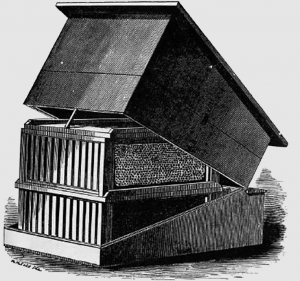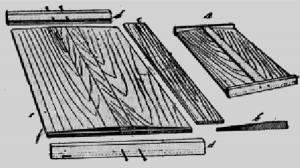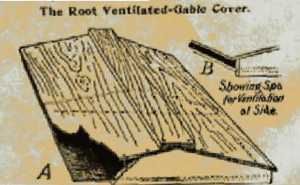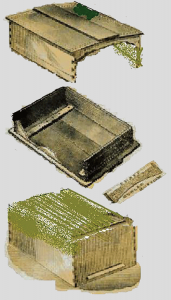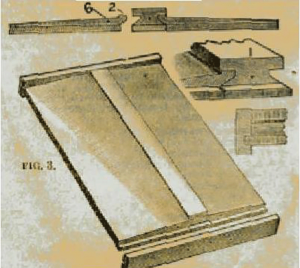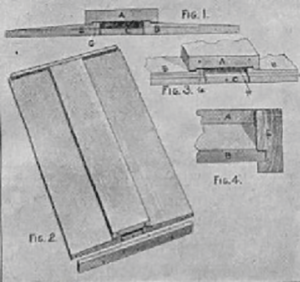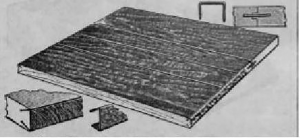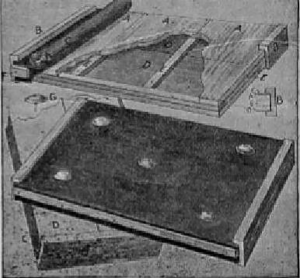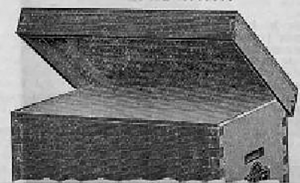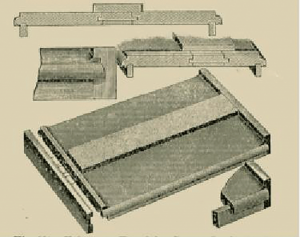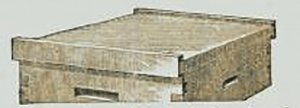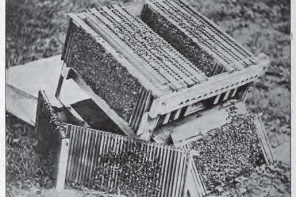By: Jim Thompson
I have found it interesting to look at the types of different beehive covers or tops that have been used over the years. I began my search with the first beehive that was patented in the United States but had a problem because the patent office burned in 1836 and many of the early written patents were destroyed.
My records show that there were 1,131 beehives patented up to 2009. Some of these hives were the same hive with improvements to keep the patent in effect. The very first beehive patented was developed by J. Sweet, April 11, 1810, in Bethlehem, MA, but that record was destroyed in the fire.
I found patent X 5,872 was granted to Ebenezer Beard in 1830 and most of the written part was recovered from the fire and had a flat attached cover. Sixty eight patented bee hives later, in 1853, Lorenzo L. Langstroth was granted a patent for a hive. Reverend Langstroth had actually developed five different models of beehives and most of his hives had flat tops. However his fifth hive was a glass hive within a hive and the outer top could be tipped forward. So it might be classified as a telescoping cover because it covered an inside hive. During the 23 years in between the Ebenezer Beard hive and the Lorenzo L. Langstroth hive there were 44 flat topped hives that had covers that were hinged, attached or simply rested on the bee hive.
There were four beehives that had covers sloping in one direction and two telescoping covers. Eleven hives had unusual shaped covers with projections and seven hives had pitched or gable tops. When you stop and think about it, it isn’t really that unusual, as the trend in the early times was to convert a piece of furniture into a bee hive and have drawers or a side panel that could be opened.
The lumber in the 1850s was available in wider widths so you could get a single piece that would cover the entire hive. However you would encounter the problem of warping or cupping, allowing the top to have gaps between the top and the super. The gaps could be viewed as being good or bad.
The gap would provide upper ventilation and an upper entrance to the hive. However, if you wanted to move the hive there was just another place for the bees to escape from the hive. Thus to eliminate the warping, the boards could be cut in narrower strips, the grain reversed and cross pieces used to hold the boards together.
This style of cover is very much like the today’s migratory cover. A problem arose, what do you do with a flat top once it is removed? You can’t just lay it on the ground in the same orientation as it would smash bees. Your best choice would be to prop it up against something else. Once a bee is smashed, the alarm pheromone is released and the other bees are now on alert. If you reverse the top and lay it on the ground, you can’t use it to stack equipment on it because it may violate bee space and squash bees.
If the top was attached by a hinge to the side of the hive some of this warping might be reduced. The hinging of the top would mean that the hinges may bind in time and you must have a little over 90 degrees movement of the top to allow frames to be removed. The covers that had projections or finials risk damage, if they are reversed and used as temporary bases for supers.
The pitched roof could be set on one side of the roof, but when you go to stack equipment on it, the equipment will be an angle and limit the amount of supers that can be stacked.
By 1895, there were three types of covers offered for sale by the A.I. Root Company. They were the Higginsville cover, the Root Ventilated Gable Cover, and the Dovetailed Chaff Hive. A Dovetailed Winter Cover was available, but it was similar in construction to the outer part of the Dovetailed Chaff Hive.
The Higginsville cover was the standard cover supplied with the purchase of a hive, unless another type was specified by the purchaser. The Higginsville cover replaced the plain flat cover with two 7¼ x 207/8 x 7/8” boards that were tapered to 3/8” along their width to allow water to drain off the roof. There was a filler strip of wood between the two side pieces and the entire top joint was covered with a 2” strip of wood. The top boards would be inset to the end pieces of wood. The end pieces of wood would allow the top to lie flat on the ground and supers could be stacked on it.
- Higginsville Cover.
- Root Ventilated – Gable Cover.
The Ventilated Gable Cover was advertised as being a cover that could be used in hot climates and places where shade was not available. It also boasted that the use of the 20 pound stone was not necessary. The intermediate top of the hive was made of ¼” material and cut into the end boards. The top pieces of wood were of 3/8” material and the highest point of the cover was two inches above the top inside board. The special feature about this cover was the ½” ventilation gap along the sides of the roof.
The Dovetailed Chaff Hive was rather unusual as it was a hive that was encased by another box which allowed the beekeeper to stuff leaves or straw into the gap between the hives from the bottom of the super. The top would telescope down over the hive but it had extra long sides. The long sides permitted an additional “box” to be inserted over the hive that could hold leaves or straw to act as insulation. In 1917 the double walled hive became known as the Buckeye Hive, sometimes it had the insulation box, but usually it was omitted.
The Dovetailed Winter case was simply the shell of the chaff hive that one could purchase to put over a single hive to protect the hive during the Winter. It was made of 3/8” thick lumber.
In 1897 the Danzy Cover was added to the Root line. This Cover was developed by Mr. Francis Danzenbaker and was similar to the Higginsville cover in that it replaced the slopping side boards with two boards that provided a flat bottom and a slopping top. Rather than a filler board and a cap in the center, the center board was grooved to accept the side boards. The end board had a straight dado so the cover would fit on the hive without any adjusting. The recommendation to prevent warping was to use lots of lead paint. It is interesting to read that the center piece was made of fine quality White Pine. When wood is exposed to the weather the softer woods tend to rot faster than the harder woods, so that may be the real reason of suggesting lots of lead paint. Lead paint is not sold today.
In 1900, the Excelsior Cover replaced the Danzy Cover, because the Excelsior Cover is better suited to warmer climates. It was mentioned that the shrinkage of the wood is less with the Excelsior Cover and that is probably due to the smaller size pieces and the construction that allows less expansion and contraction. It was a much easier cover for the company to machine.
- The Danzy Cover
- The Excelsior Cover.
An improvement to the Root Ventilated Gable cover was to put holes near the gable to allow air to circulate within the cover without any other air entering the hive.
In 1903, a new Danzenbaker Nailless cover was listed in the Root Catalog. It was a cover that consisted of several tongue and grooved boards that were held together by paint, but for additional insurance, staples were used on the ends of the boards. To keep the boards from warping, a metal strip was inserted in the saw kerfs. These covers were perfectly flat on both sides. Further testing on this top was recommended.
- New Danzenbaker Nailless Cover.
- Double Air-Spaced Cover.
Also announced in the 1903 catalog was the double air spaced cover, which had been in testing for 12 years and was giving favorable results. The cover was made of 3/8” boards which were held together with 3/8” cross boards on both sides. The end cleats were put on for added rigidity. The sides were covered with a special paper and tacked with five large headed tacks. It was recommended that the paper be painted so you would get results similar to what their tests were giving. However for five cents more, you could get metal instead of the paper.
The 1906 catalog stated that many of Root’s customers preferred the metal-roofed Double cover. Several beekeepers had expressed concern that the wood in the hive was developing checks and splits so the metal covers were developed to help their situations. An additional inner cover was needed to correct ventilation problems. These tops were available in either eight or 10 frame hives and are very similar to the telescoping covers of today. The inner cover had a relief cut in the edge that provided ventilation in the Summer time when the slot was in the up position. In the Winter, the inner cover was reversed to provide ventilation and an upper entrance for the bees.
- Metal-Roofed Cover.
- New Excelsior or Colorado Cover.
1909 saw an improvement in the Excelsior cover in that sides were added to the top. To avoid confusion the new cover was named the Colorado cover.
By 1915, the A.I. Root Company was offering only four types of cover for the hives. The metal–roofed Double cover was the standard cover supplied with their hives, but the Root Ventilated Gable cover, Excelsior cover and a flat hive cover were available. The Flat Cover had been discontinued years before, because clear lumber was hard to obtain, but it is being made again with three top boards instead of one and an option to have redwood as the top board. In later years the flat cover will be known as a migratory cover.
The Root Ventilated Gable cover was not available in 1924 from the A.I. Root Company, but other companies are making Gable type covers. Some of the hives using the Gable type covers are the decorator hives and the Garden Hive which have copper coverings.
The Root Company continued making the Buckeye Hive, the Excelsior cover which became known as the inexpensive all-wood hive cover, and the Metal roofed Double cover which became known as the metal cover up to 1933. For three years a metal top flat cover was offered and then dropped from the line. In 1940 the Buckeye Hive was dropped from the A.I. Root line. In 1944, The Root Company went to making 10-frame equipment only. From 1944 to 1955, the A.I. Root Company sold only the metal top and the inexpensive all wood top. Then the all wood top was discontinued.
It seems ironic that in the beginning of wooden beehives that the least popular type of cover became the most popular type and the most popular in the beginning became the least popular cover produced today. Perhaps I am just looking at this from the hobbyist beekeeper point of view. The Migratory Hive Cover is primarily used by beekeepers that are hauling bee hives for pollination purposes and by eliminating the two sides of a cover, allows the hives to be stacked closer together on the truck. The numbers of hives operated by commercial beekeepers far outnumber the hives of the small beekeepers.
It is also interesting to see that the problems that were facing beekeepers long ago keep being addressed today, such as the ventilation, insulation, Gable type cover, and shade issue. I remember seeing beehives that had a ½ sheet of plywood sitting on top of the hive and held in place by two concrete blocks. This was done to provide shade for the hives and ended up being more work for the beekeeper in removing blocks and plywood to get to the hive. Covers were designed so that the use of the 20 pound block wasn’t needed, but where are we today? Many beekeepers put blocks and bricks on the top of their hives to hold the covers down. However the placement of the bricks might be an indicator as to the condition of the hive. Some people have designed a catch to anchor the top to a bee hive, while others use a banding machine. I have used rocks and sticks to prop up inner covers and covers to provide hives ventilation. When I have used covers with vent slots, I have experienced spiders living in the slots. If a screen is attached over the slots, the bees will fill the screen with propolis.
There is always the search for new materials and sometimes what looks to be a good solution could end up being a disaster. Very wide stable lumber is hard to get and expensive, people have used particle board or plywood in the construction of tops. If you don’t have a waterproof glue in those materials, it is just a matter of time until they fall apart. The use of plastic seems ideal, but be careful when you need to move the hive. Plastic tops tend to have many gaps and do not hold up well if you place a hot smoker on them.
It is very hard to beat the telescoping cover as the common practice is to place it on the ground to stack equipment on when you are working the hive. If the honey supers drip honey, the honey will be caught by the cover and returned to the hive when you reassemble it. Sometimes you may wish that you had an additional cover or something else to stack equipment on, as you may want to switch supers around. Also there may be a time that you wish that you didn’t have to take a heavy super all the way to the ground but had a higher stacking point, like another short hive close by or the tail gate of a truck.
References
A.I. Root, Various Years of Bee Supply Catalogs, starting in 1895 to 1996
L.L. Langstroth, Langstroth on the Hive and the Honey Bee a Bee Keeper’s Manual, 1853.








